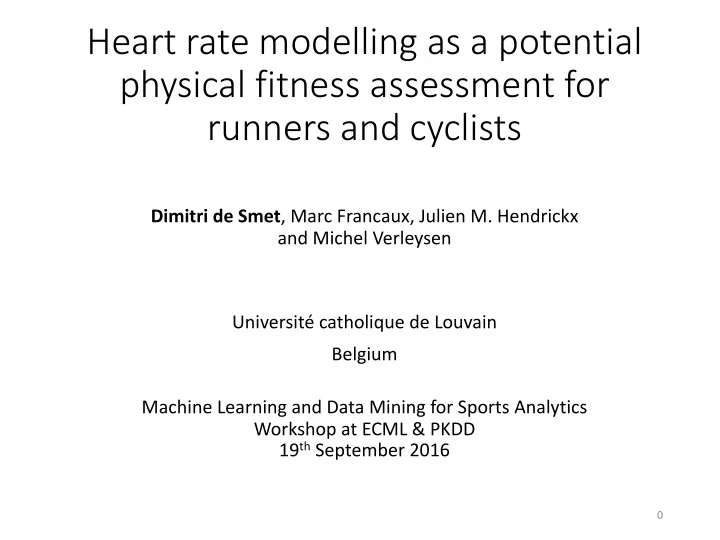

Heart rate modelling as a potential physical fitness assessment for runners and cyclists Dimitri de Smet , Marc Francaux, Julien M. Hendrickx and Michel Verleysen Université catholique de Louvain Belgium Machine Learning and Data Mining for Sports Analytics Workshop at ECML & PKDD 19 th September 2016 0
Outline • Context and machine learning perspectives • Contribution • Novel heart rate parametric model • Parameters identification • Validation • Conclusion 1
Context : automated coaching Coaches are more and more relying on scientific approach that requires a model Workout Sessions Performance Athlete Adaptation w(t) p(t) Model 2
Context : performance Exogenous variables Performance Workout Sessions p(t) Features Athlete Adaptation w(t) Sport … … extraction Model 3
Context : performance Exogenous variables Performance Workout Sessions p(t) Features Athlete Adaptation w(t) Sport … … extraction Model 5km running time • 100km running time • 100km cycling • … • 4
Context : performance Exogenous variables Performance Workout Sessions p(t) Features Athlete Adaptation w(t) Sport … … extraction Model 5km running time • 100km running time • 100km cycling • Wind speed … • • Temperature • Altitude • … • 5
Context : performance Exogenous variables Performance Workout Sessions p(t) Features Athlete Adaptation w(t) Sport … … extraction Model 5km running time • 100km running time • Athlete state • 100km cycling • Endurance • Wind speed … • • Power • Temperature • Flexibility • Altitude • Skills • … • … • 6
Context : performance Exogenous variables Performance Workout Sessions p(t) Features Athlete Adaptation w(t) Sport … … extraction Model 5km running time • Quantification • 100km running time • based on : Athlete state • 100km cycling • Duration Endurance • • Wind speed … • • Distance Power • • Temperature • Heart rate Flexibility • • Altitude • Skills zones • … • … … • • 7
Machine learning perspectives Workout Sessions Performance Features Athlete Adaptation w(t) p(t) Sport … … extraction Model Model building and athlete fitting require input- output examples: Inputs (workout sessions) • Output (performance) • 8
Data profusion • Many activity sharing platforms • Activity export = Track Track Name : Morning ride Timestamp Location (lat, lon) Altitude Heart Rate Power … Output 16.60 m 97 bpm 125 W … 2016-06-21 (50.4307, 3.736080) 13:27:28.00 16.62 m 96 bpm 147 W … 2016-06-21 (50.4308, 3.736082) 13:27:29.00 … … … … … … 9
Data profusion • Track content 10
Data profusion • Track content 11
Data profusion (strava heatmap) 12
Machine learning perspectives Workout Sessions Performance Features Athlete Adaptation w(t) p(t) Sport … … extraction Model Model building and athlete fitting require input- output examples: Inputs (workout sessions) : massively available • Output (performance) : sparse • 13
Co Contri ribution Workout Sessions Performance Features Athlete Adaptation w(t) p(t) Sport … … extraction Model Heart Rate hr(t) Heart Rate Parameters Heart rate Fitting parameters Power Output po(t) 14
Co Contri ribution Workout Sessions Performance Features Athlete Adaptation w(t) p(t) Sport … … extraction Model Heart Rate hr(t) Heart Rate Parameters Heart rate Fitting parameters Power Output po(t) contribution 15
Heart rate modelling Heart Rate hr(t) Workout Session Heart Rate Parameters Heart Rate w(t) Fitting Parameters Power Output po(t) Athlete’s heart rate parameters Heart Rate Power Output Parametric Heart Rate Model hr(t) po(t) 16
Heart rate model : steady state Parameters HR max [bpm] • Resting HR [bpm] • Slope [bpm/w] • 17
Heart rate model : steady state Parameters HR max [bpm] • Resting HR [bpm] • Slope [bpm/w] • 18
Heart rate model : transient response (measurement) d hr ( t ) + 1 τ hr ( t ) = po ( t ) dt hr ( t ) = hr ( t 0 ) + ( hr ss ( po ( t )) − hr ( t 0 )) e − t τ ( HR ( t ) + 1 τ r ( HR ss ( po ( t )) − HR ( t )) , if HR ss ( po ( t )) ≥ HR ( t ) HR ( t +1) = HR ( t ) + 1 τ f ( HR ss ( po ( t )) − HR ( t )) , if HR ss ( po ( t )) < HR ( t ) 19
Heart rate model : fatigue • Intra-session workload results in fatigue that induces increased heart rate for the same power output • Modeled by replacing po(t) by Z t po ( t ) + k f po ( t ) dt t 0 20
Heart rate modelling Athlete’s heart rate parameters Resting HR [bpm] • HR slope [bpm/watt] • HR max [bpm] • Rising time constant [s] • Falling time constant [s] • Sensitivity to fatigue • [Watt/Joule] Power Output Parametric Heart Rate Heart Rate Model po(t) hr(t) 21
Cycling activities results 22
Energy cost of running Minetti, A. E., Moia, C., Roi, G. S., Susta, D., & Ferretti, G. (2002). Energy cost of walking and running at extreme uphill and downhill slopes. Journal of applied physiology , 93 (3), 1039-1046. 23
Running activities results 24
Validation Cardiac parameters Heart Rate Power Output Heart Rate Model hr(t) po(t) • 72 Cycling activities (3 cyclists) average rmse : 4 bpm • 234 Running activities (2 runners) average rmse : 6 bpm 25
Conclusion • Pressing need for continuous fitness assessment • Our identified parameters allow for accurate heart rate simulation • Ongoing research • Our parameters Vs Laboratory measurements • Performance prediction (like race times) 26
Questions ? 27
Recommend
More recommend